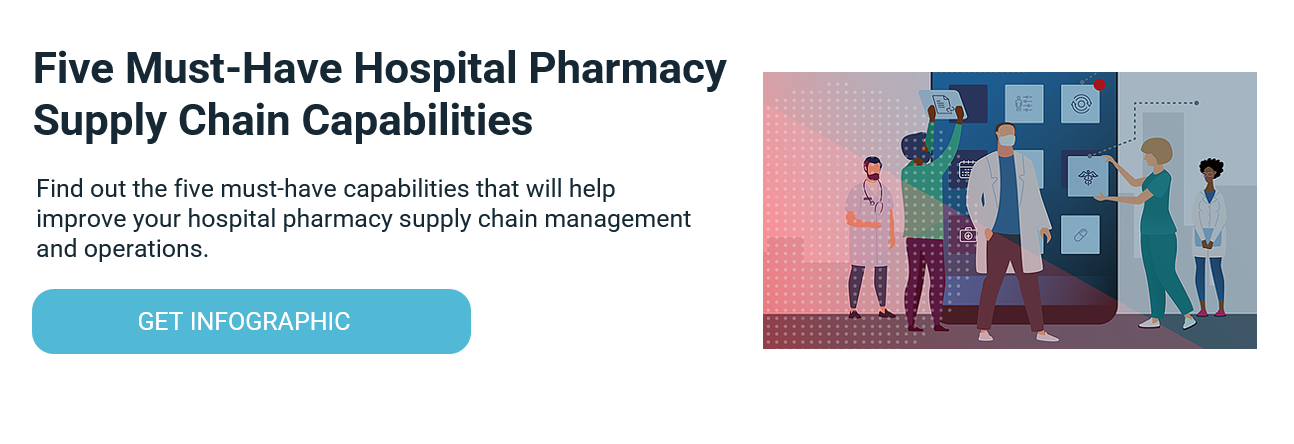4 Ways a Consolidated Service Center Can Benefit Your Pharmacy Supply Chain

Health system expenditure on prescription drugs continues to rise, with more than 80% for some drug classes (e.g., anesthetics, opioid agonists) , while drug supply shortages also continue to grow with nearly 200 drugs on the American Society of Health-System Pharmacists’ (ASHP) current shortages list.
While effective drug supply management is essential to a health system’s financial and clinical outcomes, it typically falls on the shoulders of pharmacy technicians using standalone IT systems and an abundance of manual intervention. With no visibility into their pharmacy supply chain, healthcare leaders can’t see their system’s drug inventory, let alone take steps to manage it.
To safeguard supply availability and control costs, health systems are centralizing inventory management for all supplies – general medical/surgical, special order/consignment products and pharmaceuticals – within a consolidated service center (CSC) running on an enterprise-wide supply chain management (SCM) platform.
Here are four benefits of this pharmacy supply chain approach, with commentary from Six Peaks Consulting’s healthcare supply chain experts.
1. Give Time Back to Pharmacists and Patients
Health systems that have incorporated a pharmacy supply chain system into their overall SCM processes through a CSC have relieved pharmacists of an unwelcome inventory management burden, freeing up more time for patient care.
“Having a pharma-CSC operation enables trust, something that has largely been absent on the pharmacy side in healthcare,” said Paul Ferraro, Six Peaks Consulting. “It can be helpful to have a partner in this construct for VPs of pharmacy and pharmacy directors. They begin to appreciate the things they don’t have to deal with anymore and they have folks that they feel are like an extension of themselves to trust to get the job done.”
2. Help Mitigate Supply Shortages
Experts predict that drug shortages will continue into 2022. While health systems can’t resolve production shutdowns or transport challenges, they can take steps to better manage the drug products they have in their possession.
A key benefit of drug inventory management centralization under a CSC is the ability to leverage a single supply pool across multiple care sites. By allocating a product to where it is needed through a pharmacy supply chain network, the health system can maximize its existing drug inventory to minimize expiry and waste.
3. Extend Storage Space and Enhance Security
A CSC can significantly expand a health system’s storage capabilities, providing space for climate-controlled environments necessary for certain drug types (e.g., chemotherapy). It can also serve as a central, secure storage location for controlled substances at high risk for theft.
Manufacturers deliver their products to CSCs, where upon receipt, staff members can immediately store them in the proper conditions, whether that is in a refrigerator or a locked storage area thus strengthening pharmacy supply chain operations.
4. Build Greater Buying Power
Uniting a health system’s pharmacies under a CSC umbrella and enabling the supply chain team to present the organization’s overall supply needs to manufacturers and group purchasing organizations (GPO) can open up significant savings opportunities, such as volume-based discounts.
“What the CSC does for pharmacy is it provides a single delivery location from a supplier perspective,” said Jim Grieger, Six Peaks Consulting. “If you’re going to start negotiating directly with pharma manufacturers, their first requirement will be to have a single ship-to point. This way they’ll view the system as a whole versus individual hospitals.”
Conclusion
Healthcare as an industry has been undergoing extensive consolidation as health systems acquire or merge with one another. Centralization of processes and resources has been shown to save time and money, and it is no different in the healthcare or pharmacy supply chain.
A unified approach to supply management, including pharmacy, governed by an organization-wide strategy and executed through a CSC operating on a single, electronic and automated SCM platform, brings to the table economies of scale, visibility and control; an impossible achievement when pharmacies manage supplies on their own.




